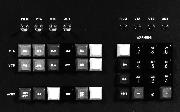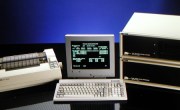|
|
|
|||
|
As a result of the experience CFI (Consolidated Film Industries) had with their CMX-200/600, they decided to develop their own online editing system. The software for this system was written by Jim Adams (Inca Data Systems). Jim continued the design of this editor when he created the Mach I. Vidtronics, one of the largest post facilities in Hollywood, had CMX-50's, 300's, and 340's. Vidtronics decided to create their own editing software for these systems. There were two major design goals. First, to provide a common user interface, second, to include a number of features not then available. This work was a joint effort between the Vidtronics engineering group and Jim Adams. Jim was later replaced by Dave Bargen, who did the majority of the software. The resulting Vidtronics Editor, was later renamed Super Edit, and became the basis of the ISC Editor, and later Grass Valley Group editor.
Jim Lindelien (of Time Logic), Joe Wolcott (on freelance assignment and a staffer at Composite Image Systems), and Gary Adams (Adams Engineering) were the principal designers of the Time Logic Controller (aka "TLC") telecine editor in 1984 as a successor to Jack Calaway’s AVRS, no longer in production. TLC incorporated, then extended, editorial principles originated in the AVRS. These included 3:2 pulldown (field-accurate editing; vs. conventional frame accuracy), and the notion of "sync points" that track the relationship of film footage to tape timecode at disparate frame rates. The TLC was designed originally for Newt Bellis and Mark Miller of Unitel Video, who contributed ideas. Unitel’s Paul Chapman, a Rank Cintel expert, contributed a lot of design insight and hands-on help…and cheerfully fixed Unitel’s Rank MK-IIIC each time we blew it up. The "generation loss" of signal quality of analog recorders was the original impetus for TLC. Accurate and repeatable edit control during the telecine transfer process avoided the then-existing requirement to re-edit transferred material. By the mid-80’s, digital transports dominated telecine bays; TLC remained desirable due to time savings and creative latitude which by then had come to be expected in telecine operations. Originally based on the CPM operating system with application code written entirely in the Forth programming language, and using five 4 MHz 8-bit Z-80 CPUs, each with 4K bytes RAM and 32K bytes of fixed code storage in EPROM. 8-inch floppies stored session settings and the most recent (single!) edit. TLC could synchronize up to two Rank Cintel or Bosch telecine transports via custom control modifications, and up to four VTRs or ATRs (typically a Nagra) under serial Sony/SMPTE RS-422 "9-pin" control. For mix effects, TLC coordinated a Grass Valley 100 switcher. NTSC transfers were field accurate, with correct 3:2 pulldown handling at the edit points; PAL and variable film speeds were supported. TLC computed necessary audio pitch correction ratios. In the mid-80’s, CPM was retired and the TLC was modified to run under a proprietary real-time kernel, again written in Forth. The Z-80’s were replaced by Hitachi’s "super Z-80" chip-the "fast" HD-64180 (8 MHz), supporting deeper RAM (32K) and EPROM (512K) space. 5.25" floppies replaced the 8", and it became possible to save the entire edit decision list to diskette for the first time. From 1981 until 1994, over 200 TLC systems were installed, predominantly in Hollywood, New York, London, and Sydney. During this period, Jim Lindelien designed and promulgated the FLEx (Film Log EDL exchange) protocol, to address industry demand for 3:2/field-accurate edit decision information captured by the TLC, and useful to other "downstream" editorial devices and processes. Support for real-time capture and editing using Kodak’s Keycode and Aaton’s film edge timecode technologies were added soon after. TLC capture of Keycode edge numbers and their relationship to video time code facilitated automatic conformation of negative cutting, to match the edited master videotape. Avid, Evertz, and many other vendors adopted TLC’s FLEx data in support of this goal. In 1994, intense competition arose between DaVinci Systems (then a unit of Dynatech) and Corporate Communications Consultants, both manufacturers of telecine color correctors and both TLC resellers. To gain exclusivity, DaVinci wholly acquired the TLC product line from Time Logic in October 1994. Gary Adams joined DaVinci at that time. For DaVinci, Jim Lindelien redesigned the TLC to synchronize up to six VTRs, and ported the design to Prolog Inc.’s 25 MHz 16-bit Intel 386 STD-bus computers running MS-DOS. This version was called "TLC2." DaVinci simultaneously migrated TLC to a single printed circuit card, for direct plug-in into their color correctors. TLC continues to be sold as of this writing, with more than 900 systems installed since the DaVinci acquisition. An early project to port TLC’s Forth code to C was abandoned. For many years, Gary Adams has maintained and extended TLC’s Forth sources to add support for new transports and editorial features.
-Jim Lindelien
|

